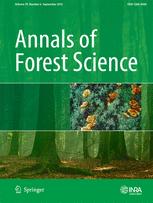Ver ítem
- xmlui.general.dspace_homeCentros Regionales y EEAsCentro Regional Patagonia NorteEEA BarilocheArtículos científicosxmlui.ArtifactBrowser.ItemViewer.trail
- Inicio
- Centros Regionales y EEAs
- Centro Regional Patagonia Norte
- EEA Bariloche
- Artículos científicos
- Ver ítem
Within-population variability in architectural traits and suitability to forestry conditions in Nothofagus nervosa (= N. alpina; Nothofagaceae)
Resumen
Context: There is evidence that Nothofagus nervosa (= N. alpina) is suitable for timber production in temperate regions due to its wood quality and fast growth. However, high intra-specific variability in the architectural traits of this species limits its usefulness.
Aims: This study was aimed at evaluating intra-specific variability in the architecture of N. nervosa trees at the population level, with emphasis on traits related to the suitability of
[ver mas...]
Context: There is evidence that Nothofagus nervosa (= N. alpina) is suitable for timber production in temperate regions due to its wood quality and fast growth. However, high intra-specific variability in the architectural traits of this species limits its usefulness.
Aims: This study was aimed at evaluating intra-specific variability in the architecture of N. nervosa trees at the population level, with emphasis on traits related to the suitability of trees for timber production.
Methods: The size of 13-year-old trees installed in an experimental field population and the extent of differentiation between trunk and branches were compared among families (trees derived from different mother trees).
Results: The large majority of trees exhibited architectural features indicative of high suitability for timber production: clear differentiation between trunk and main branches and few occurrences of permanent trunk forks, apex deaths, and sylleptic branching. Trees belonging to different families differed in height and trunk diameter. Micro-environmental conditions had a very significant effect on most architectural traits, including the trunk differentiation.
Conclusions: N. nervosa emerges as a suitable option for timber production in temperate regions. Trunk growth seems to be under both environmental and genetic control in this species.
[Cerrar]

Autor
Puntieri, Javier Guido;
Grosfeld, Javier Edgardo;
Tejera, Luis;
Mondino, Victor Alejandro;
Gallo, Leonardo Ariel;
Fuente
Annals of Forest Science 70 (5) : 471–479 (July 2013)
Fecha
2013-07
ISSN
1286-4560
1297-966X
1297-966X
Formato
pdf
Tipo de documento
artículo
Palabras Claves
Derechos de acceso
Restringido
 Excepto donde se diga explicitamente, este item se publica bajo la siguiente descripción: Creative Commons Attribution-NonCommercial-ShareAlike 2.5 Unported (CC BY-NC-SA 2.5)
Excepto donde se diga explicitamente, este item se publica bajo la siguiente descripción: Creative Commons Attribution-NonCommercial-ShareAlike 2.5 Unported (CC BY-NC-SA 2.5)

